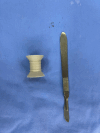Safety and feasibility of the KONO-S anastomosis technique with biodegradable stent in Crohn's disease: a pilot study
- PMID: 40263180
- PMCID: PMC12014815
- DOI: 10.1007/s00384-025-04885-y
Safety and feasibility of the KONO-S anastomosis technique with biodegradable stent in Crohn's disease: a pilot study
Abstract
Background and aims: The KONO-S (antimesenteric functional end-to-end handsewn) anastomosis has been used for Crohn's disease (CD) recently, with its efficacy in reducing the risk of anastomotic surgical recurrence. However, the anastomotic leakage is also found in CD with this technique. This study aims to evaluate the safety and feasibility of the KONO-S anastomosis with biodegradable stent in CD.
Methods: We performed a study of 56 CD patients undergoing bowel resection by the KONO-S anastomosis technique with or without biodegradable stent. Postoperative complications, time to first flatus, time to first defecation, and healing of the anastomosis were recorded, especially in patients receiving biodegradable stent.
Result: The study included 24 CD patients receiving KONO-S anastomosis with biodegradable stent and 32 patients receiving normal KONO-S anastomosis. In patients with biodegradable stent, 8 patients received small bowel resection, 15 received ileocecal resection, and 1 received colectomy; the mean time for the new anastomosis technique was 15.8 ± 2.0 min. No stent-related complications were observed postoperatively. The time to first flatus and defecation was 2.3 ± 0.5 days and 3.7 ± 0.8 days in patients with biodegradable stent, respectively. All the stents degraded at almost 4-5 weeks after surgery. The colonoscopy showed that the healing condition of the anastomosis was good without any recurrence during 6-month follow-up in the stent group.
Conclusion: This is a pilot study that showed that the KONO-S anastomosis technique with biodegradable stent was safe and feasible in CD with lower risk of anastomotic complications and no serious adverse events.
Keywords: Anastomotic leakage; Biodegradable stent; Crohn’s disease; KONO-S anastomosis.
© 2025. The Author(s).
Conflict of interest statement
Declarations. Ethics approval: This study was conducted according to the guidelines of Declaration of Helsinki, and approved by the Ethics Committee of Sir Run Run Shaw Hospital (No. 2023–630 - 01). Competing interests: The authors declare no competing interests.
Figures
Similar articles
-
Surgical Recurrence at Anastomotic Site After Bowel Resection in Crohn's Disease: Comparison of Kono-S and End-to-end Anastomosis.J Gastrointest Surg. 2019 Feb;23(2):312-319. doi: 10.1007/s11605-018-4012-6. Epub 2018 Oct 23. J Gastrointest Surg. 2019. PMID: 30353491
-
[The Kono-S anastomosis in surgery for Crohn's disease : First results of a new functional end-to-end anastomotic technique after intestinal resection in patients with Crohn's disease in Germany].Chirurg. 2019 Feb;90(2):131-136. doi: 10.1007/s00104-018-0668-4. Chirurg. 2019. PMID: 29931381 German.
-
Effect of Kono-S anastomosis on reducing postoperative recurrence rates in Crohn's disease: a systematic review and meta-analysis.Tech Coloproctol. 2024 Sep 18;28(1):127. doi: 10.1007/s10151-024-02991-7. Tech Coloproctol. 2024. PMID: 39289220
-
Kono-S Anastomosis for Surgical Prophylaxis of Anastomotic Recurrence in Crohn's Disease: an International Multicenter Study.J Gastrointest Surg. 2016 Apr;20(4):783-90. doi: 10.1007/s11605-015-3061-3. Epub 2015 Dec 22. J Gastrointest Surg. 2016. PMID: 26696531
-
Safety and effectivity of Kono-S anastomosis in Crohn's patients: a systematic review and Meta-analysis.Langenbecks Arch Surg. 2024 Jul 22;409(1):227. doi: 10.1007/s00423-024-03412-x. Langenbecks Arch Surg. 2024. PMID: 39037448 Free PMC article.
References
-
- Roda G, Chien Ng S, Kotze PG, Argollo M, Panaccione R, Spinelli A et al (2020) Crohn’s disease Nat Rev Dis Primers 6:22 - PubMed
-
- Adamina M, Minozzi S, Warusavitarne J, Buskens CJ, Chaparro M, Verstockt B et al (2024) ECCO guidelines on therapeutics in Crohn’s disease: surgical treatment. J Crohns Colitis 18:1556–1582 - PubMed
-
- Kono T, Ashida T, Ebisawa Y, Chisato N, Okamoto K, Katsuno H et al (2011) A new antimesenteric functional end-to-end handsewn anastomosis: surgical prevention of anastomotic recurrence in Crohn’s disease. Dis Colon Rectum 54:586–592 - PubMed
-
- Alibert L, Betton L, Falcoz A, Manceau G, Benoist S, Zerbib P et al (2024) Does Kono-S anastomosis reduce recurrence in Crohn’s disease compared with conventional ileocolonic anastomosis? A nationwide propensity score-matched study from GETAID Chirurgie Group [KoCoRICCO Study]. J Crohns Colitis 18:525–532 - PubMed
MeSH terms
LinkOut - more resources
Full Text Sources
Medical



